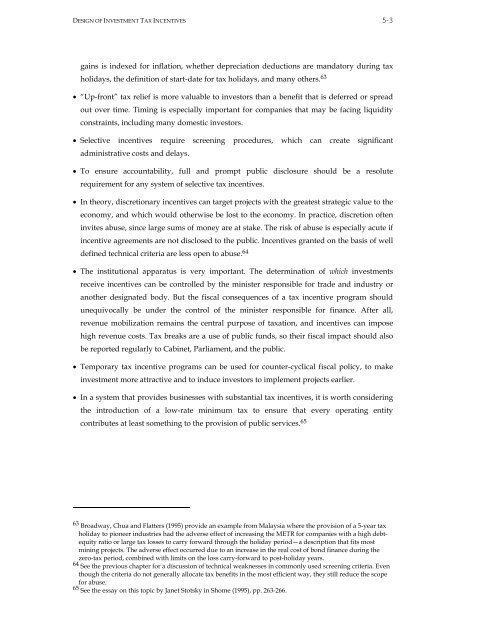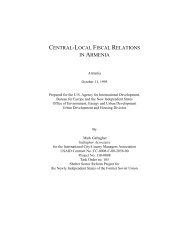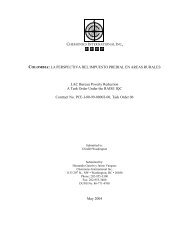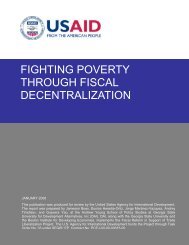Effectiveness and Economic Impact of Tax Incentives in the SADC ...
Effectiveness and Economic Impact of Tax Incentives in the SADC ...
Effectiveness and Economic Impact of Tax Incentives in the SADC ...
Create successful ePaper yourself
Turn your PDF publications into a flip-book with our unique Google optimized e-Paper software.
DESIGN OF INVESTMENT TAX INCENTIVES 5-3<br />
•<br />
•<br />
•<br />
•<br />
•<br />
•<br />
•<br />
ga<strong>in</strong>s is <strong>in</strong>dexed for <strong>in</strong>flation, whe<strong>the</strong>r depreciation deductions are m<strong>and</strong>atory dur<strong>in</strong>g tax<br />
holidays, <strong>the</strong> def<strong>in</strong>ition <strong>of</strong> start-date for tax holidays, <strong>and</strong> many o<strong>the</strong>rs. 63<br />
“Up-front” tax relief is more valuable to <strong>in</strong>vestors than a benefit that is deferred or spread<br />
out over time. Tim<strong>in</strong>g is especially important for companies that may be fac<strong>in</strong>g liquidity<br />
constra<strong>in</strong>ts, <strong>in</strong>clud<strong>in</strong>g many domestic <strong>in</strong>vestors.<br />
Selective <strong>in</strong>centives require screen<strong>in</strong>g procedures, which can create significant<br />
adm<strong>in</strong>istrative costs <strong>and</strong> delays.<br />
To ensure accountability, full <strong>and</strong> prompt public disclosure should be a resolute<br />
requirement for any system <strong>of</strong> selective tax <strong>in</strong>centives.<br />
In <strong>the</strong>ory, discretionary <strong>in</strong>centives can target projects with <strong>the</strong> greatest strategic value to <strong>the</strong><br />
economy, <strong>and</strong> which would o<strong>the</strong>rwise be lost to <strong>the</strong> economy. In practice, discretion <strong>of</strong>ten<br />
<strong>in</strong>vites abuse, s<strong>in</strong>ce large sums <strong>of</strong> money are at stake. The risk <strong>of</strong> abuse is especially acute if<br />
<strong>in</strong>centive agreements are not disclosed to <strong>the</strong> public. <strong>Incentives</strong> granted on <strong>the</strong> basis <strong>of</strong> well<br />
def<strong>in</strong>ed technical criteria are less open to abuse. 64<br />
The <strong>in</strong>stitutional apparatus is very important. The determ<strong>in</strong>ation <strong>of</strong> which <strong>in</strong>vestments<br />
receive <strong>in</strong>centives can be controlled by <strong>the</strong> m<strong>in</strong>ister responsible for trade <strong>and</strong> <strong>in</strong>dustry or<br />
ano<strong>the</strong>r designated body. But <strong>the</strong> fiscal consequences <strong>of</strong> a tax <strong>in</strong>centive program should<br />
unequivocally be under <strong>the</strong> control <strong>of</strong> <strong>the</strong> m<strong>in</strong>ister responsible for f<strong>in</strong>ance. After all,<br />
revenue mobilization rema<strong>in</strong>s <strong>the</strong> central purpose <strong>of</strong> taxation, <strong>and</strong> <strong>in</strong>centives can impose<br />
high revenue costs. <strong>Tax</strong> breaks are a use <strong>of</strong> public funds, so <strong>the</strong>ir fiscal impact should also<br />
be reported regularly to Cab<strong>in</strong>et, Parliament, <strong>and</strong> <strong>the</strong> public.<br />
Temporary tax <strong>in</strong>centive programs can be used for counter-cyclical fiscal policy, to make<br />
<strong>in</strong>vestment more attractive <strong>and</strong> to <strong>in</strong>duce <strong>in</strong>vestors to implement projects earlier.<br />
In a system that provides bus<strong>in</strong>esses with substantial tax <strong>in</strong>centives, it is worth consider<strong>in</strong>g<br />
<strong>the</strong> <strong>in</strong>troduction <strong>of</strong> a low-rate m<strong>in</strong>imum tax to ensure that every operat<strong>in</strong>g entity<br />
contributes at least someth<strong>in</strong>g to <strong>the</strong> provision <strong>of</strong> public services. 65<br />
63 Broadway, Chua <strong>and</strong> Flatters (1995) provide an example from Malaysia where <strong>the</strong> provision <strong>of</strong> a 5-year tax<br />
holiday to pioneer <strong>in</strong>dustries had <strong>the</strong> adverse effect <strong>of</strong> <strong>in</strong>creas<strong>in</strong>g <strong>the</strong> METR for companies with a high debtequity<br />
ratio or large tax losses to carry forward through <strong>the</strong> holiday period—a description that fits most<br />
m<strong>in</strong><strong>in</strong>g projects. The adverse effect occurred due to an <strong>in</strong>crease <strong>in</strong> <strong>the</strong> real cost <strong>of</strong> bond f<strong>in</strong>ance dur<strong>in</strong>g <strong>the</strong><br />
zero-tax period, comb<strong>in</strong>ed with limits on <strong>the</strong> loss carry-forward to post-holiday years.<br />
64 See <strong>the</strong> previous chapter for a discussion <strong>of</strong> technical weaknesses <strong>in</strong> commonly used screen<strong>in</strong>g criteria. Even<br />
though <strong>the</strong> criteria do not generally allocate tax benefits <strong>in</strong> <strong>the</strong> most efficient way, <strong>the</strong>y still reduce <strong>the</strong> scope<br />
for abuse.<br />
65 See <strong>the</strong> essay on this topic by Janet Stotsky <strong>in</strong> Shome (1995), pp. 263-266.











